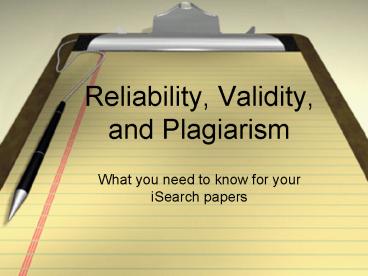Reliability, Validity, and Plagiarism PowerPoint PPT Presentation
1 / 12
Title: Reliability, Validity, and Plagiarism
1
Reliability, Validity, and Plagiarism
- What you need to know for your iSearch papers
2
What is validity?
- Validity the quality of being valid
- Duh!
- So what is valid?
- Valid well-grounded, just producing the
desired results - Remember BASED ON FACT
3
Fact or Fiction?
- Reliable honest, something that is accurate
- Reliability trustworthy, dependable
- Notice the pattern?
- BASED ON FACT
4
Lets talk about websites!
- What websites are valid and reliable?
- Examples?
- What websites are not?
- Examples?
5
NO NO ZERO
- Plagiarism the unauthorized use or close
imitation of the language and thoughts of another
author and the representation of them as one's
own original work - In other words . . . STEALING
6
Seriously?
- YES
- Plagiarism is considered stealing in ANY kind of
setting (school or business) - Why? Lets find out!
7
Original Source by M.E. Gredler
- Developing complex skills in the classroom
involves the key ingredients identified in
teaching pigeons to play ping-pong and to bowl.
The key ingredients are (1) inducing a response,
(2) reinforcing subtle improvements or
refinements in the behavior, (3) providing for
the transfer of stimulus control by gradually
withdrawing the prompts or cues, and (4)
scheduling reinforcements so that the ratio of
reinforcements in responses gradually increases
and natural reinforcers can maintain their
behavior.
8
You decide plagiarized or not?
- Inducing a response, providing for the transfer
of stimulus control by gradually withdrawing
prompts or cues, reinforcing subtle improvements
in the behavior, and scheduling reinforcements so
that natural reinforcers can maintain their
behavior are the key ingredients identified both
in teaching pigeons to play ping-pong and in
developing complex skills in the classroom.
9
So?
- THAT EXAMPLE WAS PLAGIARIZED!
- Why?
- Positive Moved words around
- Negative Copied word for word
- Negative No quotations used to cite these word
for word passages
10
What about this one?
- According to Gredler (2001), the same factors
apply to developing complex skills in a classroom
setting as to developing complex skills in any
setting. A response must be induced, then
reinforced as it gets closer to the desired
behavior. Reinforcers have to be scheduled
carefully, and cues have to be withdrawn
gradually so that the new behaviors can be
transferred and maintained.
11
So what is the difference?
- Good When you use information from ANY other
source than yourself, you MUST cite who or where
that information came from. - Sources personal interviews, books, magazines,
internet, movies, etc. - Good If you copy information word for word from
another source, you MUST use quotation marks to
quote it! - Good With ANY researched information, you must
have a works cited list that includes ALL of your
sources.
12
What Zero?
- Bad Copying information without telling the
reader where you pulled it from. - Bad Not using quotation marks when you copy
word for word. - Bad Not providing a list of all of your sources
to tell the reader what you used to gather your
research.

